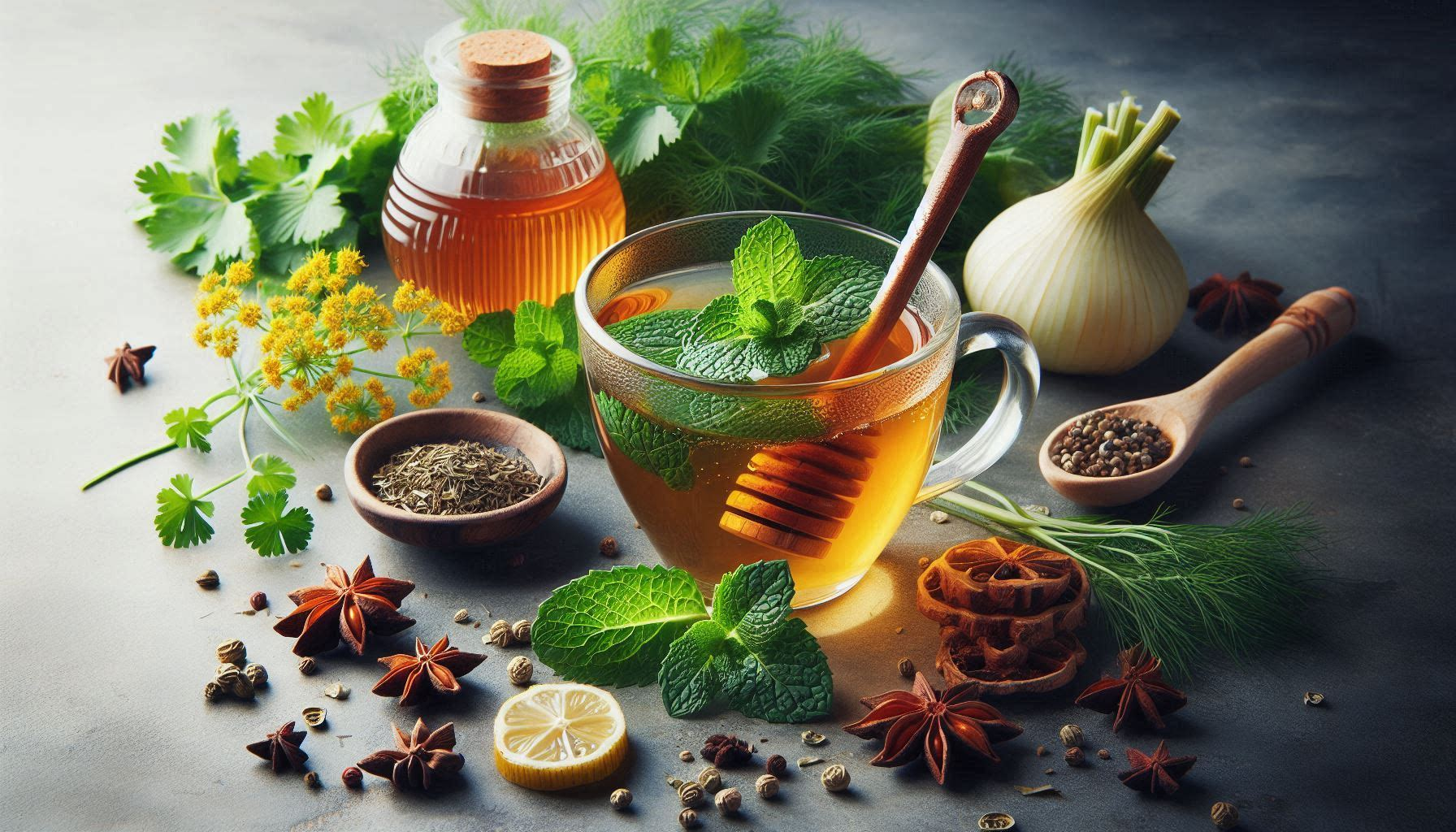As June unfolds, India experiences a fascinating blend of weather patterns. The month signifies the transition from the scorching summer having excessive heat to the refreshing arrival of the southwest monsoon. While this period brings relief from the intense temperatures, it also introduces a host of health challenges such as loss of appetite, liver issues, diarrhoea, and waterborne diseases. In Ayurveda, adapting our lifestyle and diet to the changing seasons is essential for maintaining balance and well-being. Here, we explore Ayurveda tips and tricks to beat the heat, keep the liver healthy, and manage the health challenges of June.
Understanding June's Weather in India
Northern India: The plains experience extreme heat, with temperatures often soaring above 40°C (104°F). Hill stations enjoy cooler temperatures and occasional pre-monsoon showers.
Western India: Rajasthan remains hot and dry, while coastal areas like Mumbai begin to receive heavy monsoon rains.
Southern India: Kerala and Karnataka are drenched by the monsoon, resulting in cooler weather. Tamil Nadu stays relatively dry and hot.
Eastern India: High humidity and the onset of the monsoon bring significant rainfall to West Bengal and the northeastern states.
Central India: Very hot temperatures, ranging from 35°C to 45°C (95°F to 113°F), with the monsoon arriving later in the month.
Ayurvedic Tips to Beat the Heat and Stay Healthy
In Ayurveda, balancing the doshas and adapting to seasonal changes are crucial. Here's how you can stay cool and keep your liver healthy during June:
Dietary Recommendations
Hydration is Key:
- Drink plenty of water and hydrating fluids such as coconut water, buttermilk, and herbal teas.
Here are some Ayurvedic recipes for cooling herbal teas that you can easily prepare at home. These teas are designed to help balance the Pitta dosha, which tends to get aggravated during the hot months.
1. Mint and Coriander Tea

Ingredients:
- 1 cup fresh mint leaves
- 1 cup fresh coriander leaves
- 1 teaspoon fennel seeds
- 4 cups water
- Honey or jaggery (optional, for sweetness)
Instructions:
1. Bring the water to a boil in a pot.
2. Add the mint leaves, coriander leaves, and fennel seeds to the boiling water.
3. Reduce the heat and let the mixture simmer for 5-10 minutes.
4. Remove from heat and strain the tea into cups.
5. Add honey or jaggery if desired, and serve warm or chilled.
2. Tulsi and Rose Petal Tea
Ingredients:
- 1/4 cup fresh tulsi (holy basil) leaves or 1 tablespoon dried tulsi leaves
- 2 tablespoons dried rose petals (ensure they are pesticide-free)
- 1 teaspoon fennel seeds
- 4 cups water
- Honey (optional)
Instructions:
1. Boil the water in a pot.
2. Add the tulsi leaves, rose petals, and fennel seeds to the boiling water.
3. Let the mixture simmer for 5-7 minutes.
4. Strain the tea into cups.
5. Sweeten with honey if desired, and enjoy warm or chilled.
3. Coriander Seed Tea
Ingredients:
- 1 tablespoon coriander seeds
- 4 cups water
- Lemon juice (optional)
- Honey (optional)
Instructions:
1. Crush the coriander seeds slightly to release their flavor.
2. Boil the water in a pot.
3. Add the crushed coriander seeds to the boiling water.
4. Reduce the heat and let it simmer for 10 minutes.
5. Strain the tea into cups.
6. Add a splash of lemon juice and honey if desired, and serve warm or chilled.
4. Ginger and Lemon Balm Tea
Ingredients:
- 1 tablespoon fresh grated ginger
- 1 tablespoon dried lemon balm or a handful of fresh leaves
- 4 cups water
- Honey or jaggery (optional)
Instructions:
1. Bring the water to a boil in a pot.
2. Add the grated ginger and lemon balm to the boiling water.
3. Let the mixture simmer for 5-7 minutes.
4. Strain the tea into cups.
5. Add honey or jaggery for sweetness if desired, and serve warm or chilled.
5. Amla (Indian Gooseberry) and Mint Tea
Ingredients:
- 1 tablespoon dried amla powder or a handful of fresh amla pieces
- 1/2 cup fresh mint leaves
- 4 cups water
- Honey (optional)
Instructions:
1. Boil the water in a pot.
2. Add the amla powder or fresh amla pieces and mint leaves to the boiling water.
3. Reduce the heat and let it simmer for 10 minutes.
4. Strain the tea into cups.
5. Sweeten with honey if desired, and serve warm or chilled.
Tips for Best Results:
- Freshness: Use fresh herbs and high-quality dried ingredients for the best flavor and health benefits.
- Cooling Effect: To enhance the cooling effect, you can chill the teas in the refrigerator and serve them with ice cubes.
- Hydration: These teas not only help in cooling but also aid in keeping the body hydrated and balanced.
By incorporating these Ayurvedic herbal teas into your daily routine, you can effectively cool down and stay balanced during the hot month of June. Enjoy the refreshing and healing benefits of these natural beverages!
- Infuse water with cooling herbs like mint and coriander for added benefits.
Cooling Foods:
- Include cucumbers, melons, leafy greens, and dairy products like milk and ghee in your diet.
- Favor fruits like watermelon, pomegranates, and apples to stay cool and hydrated.
Avoid Spicy and Oily Foods:
- Reduce the intake of spicy, oily, and fried foods to prevent aggravation of Pitta dosha, which is high during this season. Avoiding oily and spicy foods during the hot month of June can help keep the body cool and balanced, according to Ayurveda. Here are some healthy and refreshing alternatives that you can enjoy:
1. Salads
Cucumber and Mint Salad
- Ingredients: Cucumber, fresh mint leaves, yogurt, salt, a pinch of cumin powder.
- Instructions: Chop cucumber and mint leaves. Mix with yogurt, add salt and cumin powder to taste, and serve chilled.
Watermelon and Feta Salad
- Ingredients: Watermelon cubes, crumbled feta cheese, fresh mint leaves, lime juice.
- Instructions: Combine watermelon cubes with feta cheese and mint leaves. Drizzle with lime juice and serve chilled.
2. Smoothies and Juices
Cooling Cucumber Smoothie
- Ingredients: Cucumber, plain yogurt, fresh mint leaves, a pinch of salt.
- Instructions: Blend cucumber, yogurt, mint leaves, and salt until smooth. Serve immediately.
Amla and Mint Juice
- Ingredients: Fresh amla (Indian gooseberry), fresh mint leaves, honey, water.
- Instructions: Blend amla and mint leaves with water. Strain the mixture, add honey to taste, and serve chilled.
3. Soups
Cold Cucumber and Avocado Soup
- Ingredients: Cucumber, avocado, plain yogurt, fresh dill, salt, and pepper.
- Instructions: Blend cucumber, avocado, and yogurt until smooth. Add chopped dill, salt, and pepper. Serve chilled.
Mint and Pea Soup
- Ingredients: Fresh peas, vegetable broth, fresh mint leaves, salt, and pepper.
- Instructions: Cook peas in vegetable broth until tender. Blend with mint leaves, add salt and pepper to taste. Serve warm or chilled.
4. Light Main Courses
Quinoa and Veggie Bowl
- Ingredients: Quinoa, cherry tomatoes, cucumber, bell peppers, fresh herbs (like parsley and cilantro), lemon juice, olive oil, salt, and pepper.
- Instructions: Cook quinoa as per package instructions. Mix with chopped vegetables and herbs. Drizzle with lemon juice, olive oil, salt, and pepper.
Mung Bean Sprout Salad
- Ingredients: Mung bean sprouts, grated carrot, chopped cucumber, fresh cilantro, lemon juice, salt, and pepper.
- Instructions: Combine mung bean sprouts with grated carrot, cucumber, and cilantro. Drizzle with lemon juice, add salt and pepper to taste.
5. Snacks
Fruit Chaat
- Ingredients: Seasonal fruits (like apples, bananas, pomegranates, and oranges), a pinch of chaat masala, lemon juice.
- Instructions: Chop fruits into bite-sized pieces. Sprinkle with chaat masala and lemon juice. Mix well and serve.
Yogurt and Berry Parfait
- Ingredients: Plain yogurt, fresh berries (like strawberries, blueberries, and raspberries), honey, granola.
- Instructions: Layer yogurt with fresh berries and granola in a glass. Drizzle with honey and serve.
6. Beverages
Lemon and Mint Infused Water
- Ingredients: Water, lemon slices, fresh mint leaves.
- Instructions: Add lemon slices and mint leaves to a jug of water. Let it infuse for a few hours in the refrigerator and serve chilled.
Coconut Water with Basil Seeds
- Ingredients: Fresh coconut water, soaked basil seeds (sabja seeds).
- Instructions: Add soaked basil seeds to coconut water and serve chilled.
By incorporating these healthy and refreshing alternatives into their diet, you can enjoy delicious meals and snacks that help keep their bodies cool and balanced during the hot month of June. These recipes are not only light and nutritious but also align with Ayurvedic principles for maintaining health and well-being.
Moderate Sour and Salty Foods:
- While these can help balance Vata dosha during the rainy season, consume them in moderation to avoid Pitta imbalance.
Light and Fresh Meals:
- Focus on light, easily digestible meals. Include soups, stews, and salads to keep your digestive system at ease.
Foods to Keep the Body Cool
Cucumbers and Melons: High water content and cooling properties make them perfect for hot weather.
Leafy Greens: Spinach, lettuce, and other greens provide essential nutrients while keeping the body cool.
Yogurt and Buttermilk: Probiotics aid digestion and have a cooling effect.
Herbs: Coriander, mint, and fennel seeds are excellent for cooling the body and supporting digestion.
Coconut Water: Naturally hydrating and rich in electrolytes.
Lifestyle Adjustments
Wear Light Clothing:
- Opt for light, breathable, and loose-fitting clothing made of natural fibres like cotton.
Rest and Sleep:
In Ayurveda, the sleep cycle and daily routines, known as dinacharya, are tailored to maintain harmony with the natural rhythms of the environment and the body. During the month of June, when the weather is transitioning from hot summer to the beginning of the monsoon season, certain adjustments to the sleep cycle can help balance the doshas and maintain optimal health. Here are some Ayurvedic recommendations for managing the sleep cycle in June:
Ayurvedic Sleep Recommendations for June
1. Consistent Sleep Schedule:
- Go to Bed Early: Ayurveda suggests going to bed early, around 10 PM. This aligns with the body’s natural circadian rhythms and helps in the proper rest and rejuvenation of the body.
- Wake Up Early: Aim to wake up early, around 5-6 AM, before sunrise. Early morning is considered a time of Vata dosha, which promotes alertness and creativity.
2. Cooling and Calm Environment:
- Cool Sleep Environment: Ensure your sleeping environment is cool and well-ventilated. Use fans, air coolers, or air conditioning to maintain a comfortable temperature.
- Calming Atmosphere: Create a calming atmosphere in your bedroom. Use soft lighting, soothing scents like lavender or sandalwood, and ensure the space is clean and clutter-free.
3. Pre-Bedtime Routine:
- Wind Down: Engage in relaxing activities before bed. This can include gentle yoga, meditation, or reading a calming book.
- Avoid Stimulation: Avoid stimulating activities and electronics at least an hour before bedtime. This helps the mind and body to wind down naturally.
4. Diet and Hydration:
- Light Evening Meal: Have a light dinner, ideally before 7 PM. Avoid heavy, spicy, or oily foods that can disrupt digestion and disturb sleep.
- Stay Hydrated: Drink adequate water throughout the day, but reduce fluid intake close to bedtime to avoid frequent trips to the bathroom during the night.
5. Herbal Aids:
- Herbal Teas: Drink calming herbal teas like chamomile, valerian root, or a mix of cooling herbs like mint and coriander before bed to promote restful sleep.
- Natural Remedies: Use natural sleep aids like warm milk with a pinch of nutmeg or turmeric, which have calming properties and support good sleep.
6. Balancing Doshas:
- Pitta Dosha Balance: Since Pitta dosha can be aggravated due to the heat of summer, focus on balancing Pitta by keeping cool and avoiding excessive heat and stress.
- Relaxation Practices: Incorporate relaxation practices such as Abhyanga (self-massage) with cooling oils like coconut or sandalwood oil before bed.
Following these Ayurvedic recommendations for the sleep cycle in June can help maintain balance and well-being during the seasonal transition. By establishing a consistent sleep schedule, creating a cool and calming sleep environment, and incorporating soothing pre-bedtime routines, you can ensure restful and rejuvenating sleep. Adopting these practices will help you stay aligned with the natural rhythms and support overall health and harmony during the hot and humid month of June.
Moderate Exercise:
- Engage in moderate physical activity, preferably during the cooler parts of the day. Avoid excessive exertion.
Stay Cool:
- Use fans, air coolers, or air conditioning to keep living spaces cool. Avoid direct sun exposure during peak hours.
Hygiene and Preventive Measures
Regular Bathing:
- Take cool showers or baths to regulate body temperature and maintain hygiene.
Skincare:
- Use natural cooling skincare products like aloe vera gel and coconut oil to soothe and protect your skin.
In Ayurveda, skincare is deeply connected to balancing the doshas and adapting to the changing seasons. During the month of June, which marks the transition from the hot summer to the beginning of the monsoon season in India, the skin can experience increased heat and humidity, leading to various skin issues. Here are some Ayurvedic recommendations for maintaining healthy skin in June:
1. Hydration and Moisturization
- Stay Hydrated: Drink plenty of water, coconut water, and herbal teas to keep your skin hydrated from the inside out.
- Light Moisturizers: Use light, natural moisturizers like aloe vera gel or coconut oil to keep the skin moisturized without feeling greasy.
2. Cleansing and Exfoliation
- Gentle Cleansing: Use gentle, natural cleansers to remove sweat, dirt, and impurities without stripping the skin of its natural oils. Neem and rose water are excellent choices.
- Exfoliation: Regular exfoliation helps remove dead skin cells and unclog pores. Use a gentle scrub made from chickpea flour (besan) and turmeric mixed with rose water or milk.
3. Cooling and Soothing Treatments
- Aloe Vera Gel: Apply fresh aloe vera gel to soothe and cool the skin. Aloe vera is excellent for reducing inflammation and hydrating the skin.
- Cucumber Masks: Make a refreshing face mask using cucumber juice or puree. It helps in cooling the skin and reducing puffiness.
- Sandalwood Paste: Sandalwood has cooling properties and can be applied as a paste mixed with rose water to reduce heat and soothe the skin.
4. Sun Protection
- Natural Sunscreens: Protect your skin from the harsh sun by using natural sunscreens like aloe vera or coconut oil with a few drops of carrot seed oil, which has natural SPF properties.
- Cover Up: Wear light, breathable clothing and a wide-brimmed hat to protect your skin from direct sun exposure.
5. Diet for Healthy Skin
- Cooling Foods: Incorporate cooling foods into your diet, such as cucumbers, melons, leafy greens, and mint. These help balance Pitta dosha and keep the skin hydrated.
- Avoid Spicy and Oily Foods: Reduce the intake of spicy and oily foods, which can aggravate Pitta and lead to skin issues like acne and rashes.
- **Fresh Fruits and Vegetables:** Consume a diet rich in fresh fruits and vegetables to provide essential vitamins and antioxidants for healthy skin.
6. Herbal Remedies
- Herbal Toners: Use natural toners like rose water or cucumber water to refresh and hydrate the skin throughout the day.
- Tulsi and Neem: These herbs have antibacterial properties and can be used in face packs or cleansers to prevent acne and other skin infections.
7. Routine Practices
- Regular Bathing: Take cool showers or baths to regulate body temperature and keep the skin clean and fresh.
- Abhyanga (Oil Massage): Perform self-massage with cooling oils like coconut or olive oil to improve circulation and nourish the skin.
8. Stress Management
- Meditation and Yoga: Practice meditation and gentle yoga to reduce stress, which can affect skin health. Focus on cooling pranayama (breathing exercises) like Sheetali and Sheetkari.
Sheetali and Sheetkari are two cooling pranayama (breathing exercises) techniques that are especially beneficial during hot weather or to reduce stress and anxiety. Here's how to perform each of them:
Sheetali Pranayama (Cooling Breath)

Steps:
1. Sit comfortably in a cross-legged position (Sukhasana) or on a chair with your spine erect and shoulders relaxed.
2. Close your eyes and take a few deep breaths to relax your body and mind.
3. Roll your tongue into a tube-like shape, protruding it slightly past your lips.
4. Inhale deeply and slowly through the rolled tongue, feeling the coolness of the breath as it passes over your tongue and into your mouth and throat. Focus on the sensation of coolness.
5. After inhaling fully, close your mouth and exhale slowly and completely through your nostrils.
6. Repeat this cycle for several rounds, maintaining a smooth and steady rhythm. Aim for 5-10 rounds initially, gradually increasing as you become more comfortable with the practice.
Benefits:
- Sheetali Pranayama cools the body and calms the mind, making it particularly beneficial during hot weather or when feeling agitated or stressed.
- It can help reduce body heat, alleviate thirst, and improve digestion.
- Sheetali also purifies the blood and enhances overall respiratory health.
Sheetkari Pranayama (Hissing Breath)

Steps:
1. Sit comfortably in a cross-legged position or on a chair with your spine erect and shoulders relaxed.
2. Close your eyes and take a few deep breaths to center yourself.
3. Place the tip of your tongue against the roof of your mouth, just behind your front teeth.
4. Part your lips slightly, keeping your teeth together, creating a hissing sound similar to the sound of a snake.
5. Inhale slowly and deeply through your mouth, drawing the breath in through the gaps between your teeth, while maintaining the hissing sound.
6. After inhaling fully, close your mouth and exhale slowly and completely through your nostrils.
7. Repeat this cycle for several rounds, maintaining a smooth and steady rhythm. Aim for 5-10 rounds initially, gradually increasing as you become more comfortable with the practice.
Benefits:
- Sheetkari Pranayama has similar cooling effects to Sheetali and is beneficial for reducing body heat and calming the mind.
- It helps regulate blood pressure and balances the nervous system.
- Sheetkari also improves focus, concentration, and mental clarity.
Precautions:
- If you have any respiratory conditions or dental issues that make it difficult to perform these practices, consult with a qualified yoga instructor or healthcare professional before attempting Sheetali or Sheetkari Pranayama.
- Always practice pranayama mindfully and listen to your body. If you feel dizzy, lightheaded, or uncomfortable at any point, stop the practice and return to normal breathing.
Incorporate Sheetali and Sheetkari Pranayama into your daily yoga or meditation routine to experience their cooling and calming benefits, especially during the hot summer months or times of stress and agitation.
- Adequate Sleep: Ensure you get enough sleep, as it is essential for skin repair and regeneration.
9. Preventing and Treating Common Skin Issues
- Acne and Pimples: Use a paste of sandalwood and turmeric to treat acne. Neem paste can also be effective in reducing pimples and preventing breakouts.
- Rashes and Heat Bumps: Apply aloe vera gel or a paste made from sandalwood and rose water to soothe and heal heat rashes and bumps.
Conclusion
Adopting these Ayurvedic skincare practices during June can help you maintain healthy, glowing skin despite the heat and humidity. By focusing on hydration, gentle cleansing, cooling treatments, and a balanced diet, you can effectively manage the skin challenges posed by this transitional season. Embrace these natural, holistic approaches to skincare for optimal results and overall well-being.
Digestive Health:
- Incorporate herbs and spices like cumin, coriander, and fennel to support digestion. Consider Ayurvedic herbs like Triphala to maintain digestive balance.
Boost Immunity:
- Consume immunity-boosting herbs like Tulsi (holy basil), ginger, and turmeric to strengthen your body against infections.
Mental and Emotional Well-being
Meditation and Yoga:
- Practice meditation and gentle yoga to maintain mental calmness and emotional stability.
Reduce Stress:
- Engage in relaxation techniques and mindful activities to support overall well-being.
Conclusion
June in India is a month of transition, bringing both the intense heat of summer and the refreshing onset of the monsoon. By embracing Ayurvedic principles and making mindful adjustments to our diet and lifestyle, we can stay cool, keep our liver healthy, and manage common health challenges effectively. Incorporate these Ayurvedic tips and enjoy a healthy, balanced June!

